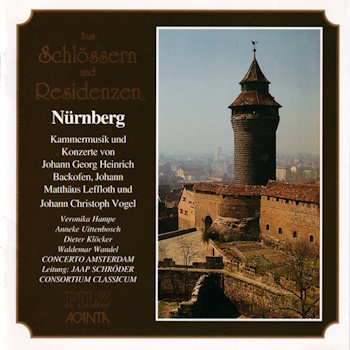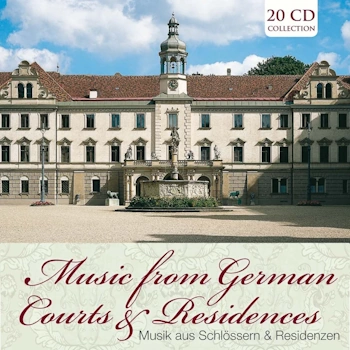 |
|
2 LPs
- 29 21193-2 - (p) 1972
|
 |
| 2 CDs -
44 2166-2 - (c) 1993 |
|
NÜRNBERG
|
|
|
|
|
|
|
|
| Johann
Matthäus LEFFLOTH (1705-1731) |
Konzert
D-Dur für obligates Cembalo und
Violine |
LP 1 |
|
9' 48" |
|
|
-
Andante
|
|
2' 05" |
|
A1 |
|
-
Allegro
|
|
3' 29" |
|
A2 |
|
-
Adagio |
|
2' 26" |
|
A3 |
|
-
Bourrée en Rondeau
|
|
1' 43" |
|
A4 |
|
(Anneke
Uittenbosch: Cembalo | Jaap
Schröder: Violine)
|
|
|
|
|
| Johann Matthäus LEFFLOTH |
Sonate
C-Dur für Viola da gamba und
Cembalo |
LP 1 |
|
11' 34" |
|
|
-
Adagio
|
|
2' 35" |
|
A5 |
|
-
Allegro |
|
2' 29" |
|
A6 |
|
-
Adagio |
|
3' 29" |
|
A7 |
|
-
Allegro |
|
2' 56" |
|
A8 |
|
(Veronika Hampe:
Viola da gamba | Anneke
Uittenbosch: Cembalo)
|
|
|
|
|
| Johann Christoph VOGEL
(1758-1788) |
Quartett
B-Dur für Klarinette, Violine,
Viola und Violoncello
|
LP 1 |
|
18' 13" |
|
|
-
Allegro non molto
|
|
6' 32" |
|
B1 |
|
-
Thema con variazioni
|
|
5' 11" |
|
B2 |
|
-
Adagio
|
|
2' 43" |
|
B3 |
|
-
Rondo: Allegro |
|
3' 42" |
|
B4 |
|
(Consortium
Classicum)
|
|
|
|
|
| Johann Georg Heinrich
BACKOFEN (1768-1830) |
Sinfonia
concertante A-Dur für 2
Klarinetten und Orchester |
LP 2 |
|
18' 53" |
|
|
-
Allegro
|
|
8' 27" |
|
C1 |
|
-
(ohne Satzbezeichnung)
|
|
5' 01" |
|
C2 |
|
-
Rondo |
|
5' 21" |
|
C3 |
|
(Dieter Klöcker,
Waldemar Wandel: Klarinette) |
|
|
|
|
| Johann Georg Heinrich
BACKOFEN |
Quintett
B-Dur für Klarinette, Violine, 2
Violen und Violoncello
|
LP 2 |
|
17' 46" |
|
|
-
Allegro moderato
|
|
9' 06" |
|
D1 |
|
-
Cantabile con variazioni
|
|
8' 38" |
|
D2 |
|
(Consortium
Classicum) |
|
|
|
|
|
|
|
|
| Johann
Christoph VOGEL: Quartett B-Dur |
J. G.
H. BACKOFEN: Sinfonia concertante
|
J. G.
H. BACKOFEN: Quintett B-Dur
|
|
|
|
|
|
CONSORTIUM
CLASSICUM
|
CONCERTO
AMSTERDAM
|
CONSORTIUM
CLASSICUM |
|
| - Dieter Klöcker, Klarinette
|
Jaap SCHRÖDER,
Leitung
|
- Dieter Klöcker, Klarinette
|
|
| - Rainer Kussmaul, Violine |
|
- Rainer Kussmaul, Violine
|
|
| - Jürgen Kussmaul, Viola |
|
- Jürgen Kussmaul, Viola
|
|
| - Anner Bylsma, Violoncello |
|
- Anner Bylsma, Violoncello
|
|
|
|
- Paul Schröder, 2.
Viola |
|
|
|
|
|
Recorded
at: |
|
-
|
|
|
Live / Studio
|
|
Studio |
|
|
Producer |
|
-
|
|
|
Balance engineer
|
|
-
|
|
|
First LP Edition
|
|
BASF
| 29 21193-2 | 2 LPs | durata
39' 35" - 36' 39" | (p)
1972
|
|
|
First CD Edition |
|
PILZ
- ACANTA | 44 2166-2 | 2 CDs |
durata 39' 35" - 36' 39" | (c)
1993 | ADD
|
|
|
Note |
|
-
|
|
|
|
|
Musik
aus Schlössernb &
Residenzen
(20 CD Collection)

Membran |
234355 | (c) 2016
(in CD 9
& 10)
|
Scarcely
any other town of comparable
size reflects the course of
German history, with all its
vicissitudes, as does the old
„Free Imperial City“ of
Nuremberg; and, woven into the
intricate web of political,
economic, religious and cultural
developments, music, in
particular, stands out vividly
in all its varied forms. In the
14th and 15th centuries it was
chiefly the Community’ s
flourishing foreign trade that
enabled the arts to enjoy
similar good fortune and develop
to an unprecedented degree. In
the first half of the 15th
century Nuremberg had already
produced within its ancient
walls the first great name in
the musical history of Germany,
Konrad Paumann (c. 1415 -1473),
the great pioneer of organ and
lute playing. Closely connected
with the development of organ
music there grew up at the same
time another new art-form, the
German Lied, whose main sources
were also to be found in
Nuremberg: the
„Lochamer-Liederbuch“ (1452 -
1460) and the song-book of
Hartmann Schedel (1460 - 1467).
At the time of Albrecht Dürer
(1471 - 1528), when Nuremberg
was at the peak of its cultural
and political development, the
foundations were laid for the
two thriving musical industries
of the future, instrument making
and music printing and
publishing. The new humanistic
learning of the period also made
its presence felt and led to the
reform of musical instruction in
schools, the driving forces in
this direction being Johannes
Cochläus and Sebald Heyden. The
city produced two composers of
note, Conrad Rein, the teacher
of Hans Sachs, and Wilhelm
Breitengraser. Adolf Blindhamer,
former court lutenist to Emperor
Maximilian I, and his pupil Hans
Gerle and Hans Neusiedler became
leading exponents of the art of
lute-playing and also produced
excellent compositions for this
instrument. Although the middle
of the 16th century saw a
decline in the city’s musical
activities, from 1575 onwards
the city received renewed
impetus from Friedrich Lindner
and, in particular, Leonhard
Lechner, who secured a place for
Nuremberg again among the
musical centres of Southern
Germany. As a result of the
successful blending of the old
German and Flemish musical
styles with the new Italian
madrigalian devices in vocal
writing a „new German Lied“
emerged, mainly due to the work
of Lechner, which found its
culmination in the masterly
compositions of Hans Leo
Hassler.
It would seem that the most
concentrated, substantial
picture of Nuremberg’s musical
life is presented in the Baroque
era, when the city directed its
cultural efforts along a course
completely independent of any
neighbouring musical activities.
This is all the more remarkable
as the political and economic
importance of the city had
noticeably declined during the
Thirty Years’ War and after the
devastating plague years of the
17th century. In contrast to the
prevailing pattern of musical
life as witnessed in the other
„free imperial cities“ and royal
courts of Germany at that time,
the focal point of which was
always the reigning chief
conductor or choirmaster,
Nuremberg’s musical activities
revolved round its organists.
The work of these Nuremberg
masters was strongly determined
by the great tradition of organ
playing which had grown up in
Nuremberg and continued to be
handed down from teacher to
pupil for a period of over five
generations, stretching from
Johann Staden through to
Pachelbels son Wilhelm
Hieronymus and the threshold of
the classic era. Such continuity
of teaching was quite unique in
Germany and one can with
justification speak of a
„Nuremberg School“: Staden was
the teacher of Johann Erasmus
Kindermann, whose pupils
Heinrich Schwemmer and Georg
Kaspar taught Johann Krieger and
Johann Pachelbel. A flowing
cantabile style of writing,
tight-knit formal construction,
a simple tunefulness and lack of
any overdramatic pathos
characterized the
Franconian-Baroque, Nuremberg
style.
Johann Matthäus Leffloth was
able to benefit from the musical
heritage of the „Nuremberg
School“. Born in February 1705,
the son of a Nuremberg merchant
and organist, he received his
early musical instruction from
Wilhelm Hieronymus Pachelbel
and, aged only 18 years, was
appointed organist of St.
Leonhard’s. The promising young
genius, however, died in October
1731 at the early age of 27. His
compositions for keyboard
instruments clearly show the
influence of the Italian style.
The fact that his Sonata for
Viola da gamba and Harpsichord
in C major, recorded here, was
once erroneously thought to be
by George Frideric Handel is
proof enough in itself of the
substance of this composer’s
works.
Although in the 18th century
Nuremberg, compared with other
South German musical centres
such as Mannheim, Munich and
Vienna, was somewhat out of the
mainstream of contemporary
musical activity, it,
nevertheless, in that period
too, played a significant role.
Evidence of this is provided by
the music printing and
publishing trade, which was
thriving once again. It was to
the Nuremberg music engravers
and publishers Christoph Weigel
and Balthasar Schmid that Johann
Sebastian Bach himself entrusted
the printing of three of his
works (few of which were ever
printed during the composer’s
lifetime). It is true that some
of the city’s talents had to
seek their fortunes elsewhere.
Thus Johann Christoph Vogel,
born in 1756 into an old
Nuremberg family of lute and
violin makers, decided to settle
in Paris in 1777, where, like
Leffloth, he suffered an
untimely death at the age of 32.
Vogel always regarded Christoph
Willibald Gluck as his real
teacher in composition. He
himself was considered one of
the most important operatic
composers between Gluck and
Mozart. Whereas a revival of
Vogel’s operas in our days has
proved unsuccessful, there is a
growing interest in his
instrumental works, a number of
which are becoming increasingly
popular. Written originally to
provide for the court orchestras
of the French nobility, they
have a charming musical
freshness which appeals today.
One instrument that features
prominently in much of Vogel’s
chamber music is the clarinet.
This is significant as it was
from the city of Nuremberg that
this instrument set out on its
triumphal progress through
musical Europe, for around the
year 1700 Johann Christoph
Denner of Nuremberg produced the
first key-chalumeau, the
immediate forerunner of the
clarinet.
The composer Johann Georg
Heinrich Backofen was also a
virtuoso clarinetist. The
Backofen family, of which there
were numerous branches, was the
one musical family to achieve
any prominence during
Nuremberg’s last years of glory
as a „free imperial city“.
J.G.H. Backofen was born at
Durlach in 1768. In 1780 he and
two of his brothers became
apprenticed to Capellmeister
Georg Wilhelm Gruber in
Nuremberg. He remained in
Nuremberg until 1806 and died in
1830 in Darmstadt, where he had
been a member of the Court
Orchestra. In addition to
composing, Backofen also
compiled excellent text books on
the principles of playing both
the clarinet and the harp. His
concertos and concertante
symphonies for various solo
instruments and orchestra, which
were widely performed during his
lifetime, date, for the most
part, from his years in
Nuremberg, a time when the
former medieval Franconian
metropolis, through people like
Wilhelm Heinrich Wackenroder and
Ludwig Tieck in particular, was
already being „discovered“ by
the new Romantic movement.
Franz Krautwurst
|
|